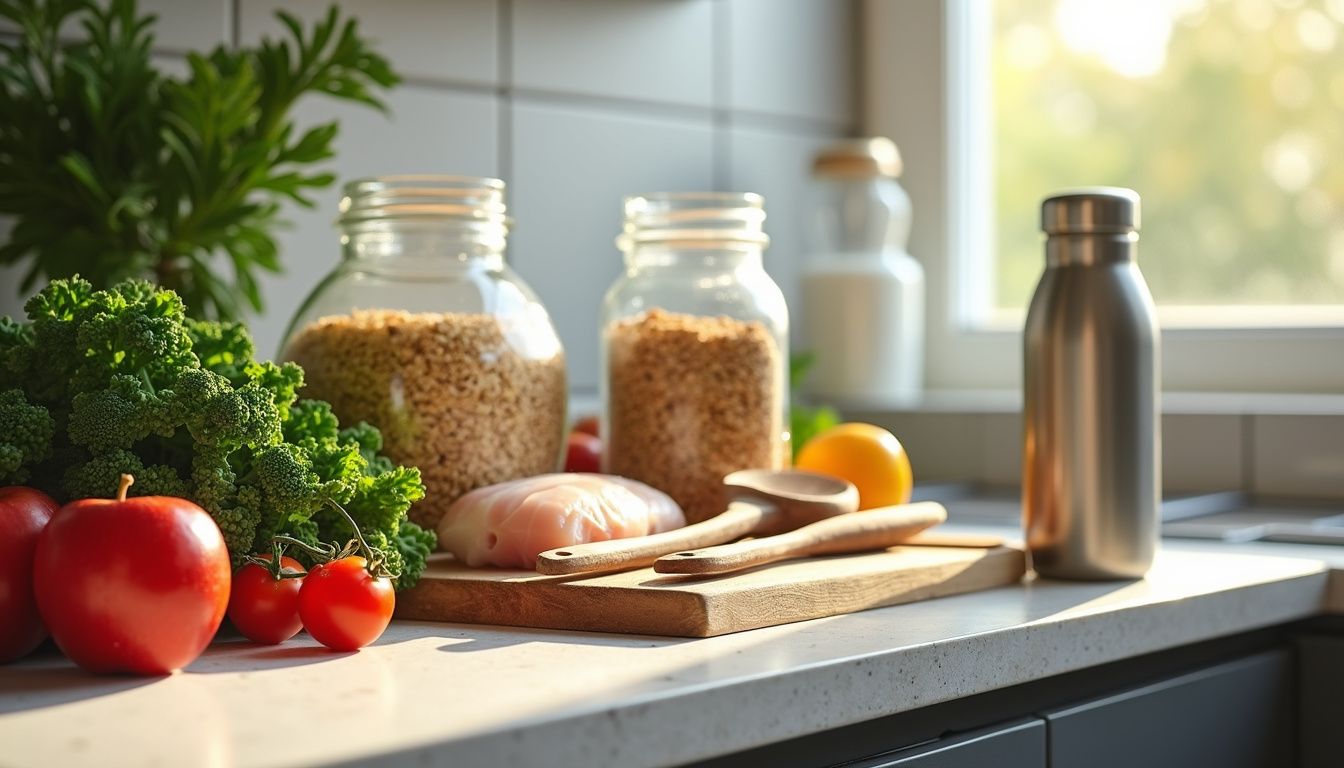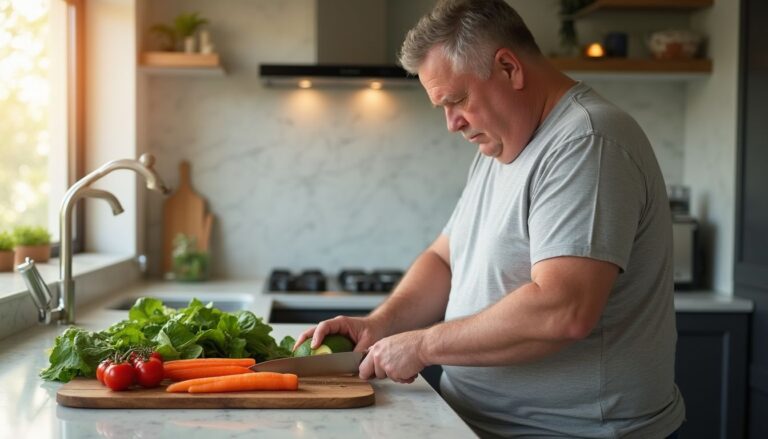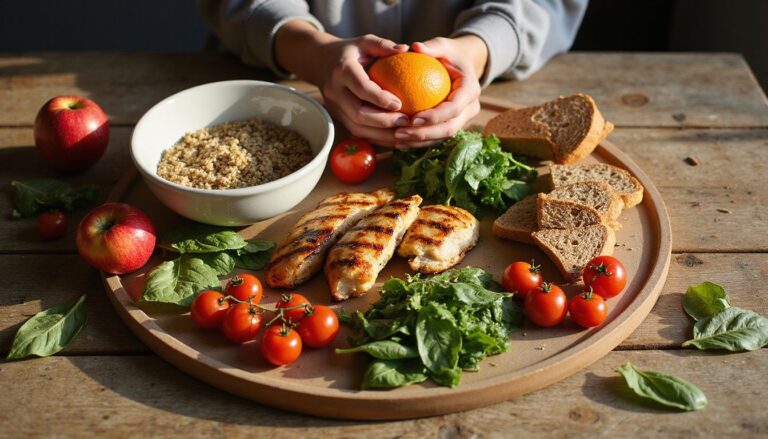7-Day Fat Loss Diet Plan: Healthy Eating Meal Plan For Weight Loss
Our Nutrition Assistant AI Suite will transform your body. You will lose fat, get toned, and build muscle. Gain confidence and optimal health.
If you want a simple way to lose body fat and start healthy eating, a clear diet plan helps. The Mayo Clinic Diet offers a structured meal plan to guide better habits and long-term weight management. This 7-day meal plan shows you what to eat, how much to eat, and how to pair food with daily activity so you can see steady progress.
You will get easy meals that keep you full, plus tips on portions, hydration, and movement. If you are ready for an evidence-based plan to help you lose weight, start here and follow the steps day by day.
Key Takeaways
- The Mayo Clinic Diet 7-day plan creates a calorie deficit of about 1,200-1,500 calories per day, which can help you lose 6-10 pounds in two weeks.
- Target at least 80 grams of protein and 30 grams of dietary fiber daily from lean meats, beans, vegetables, fruit, whole grains, nuts, and seeds.
- Limit sweets to about 75 calories per day and aim for sodium under roughly 1,700 milligrams for heart health and blood pressure control.
- Do at least 30 minutes of physical activity each day, as advised by Mayo Clinic and the CDC, to protect muscle and speed fat loss.
- High-fiber eating patterns, supported by studies such as Kelly RK et al., Front Nutr., 2023, help with weight control and reduce risks for diabetes and cardiovascular disease.
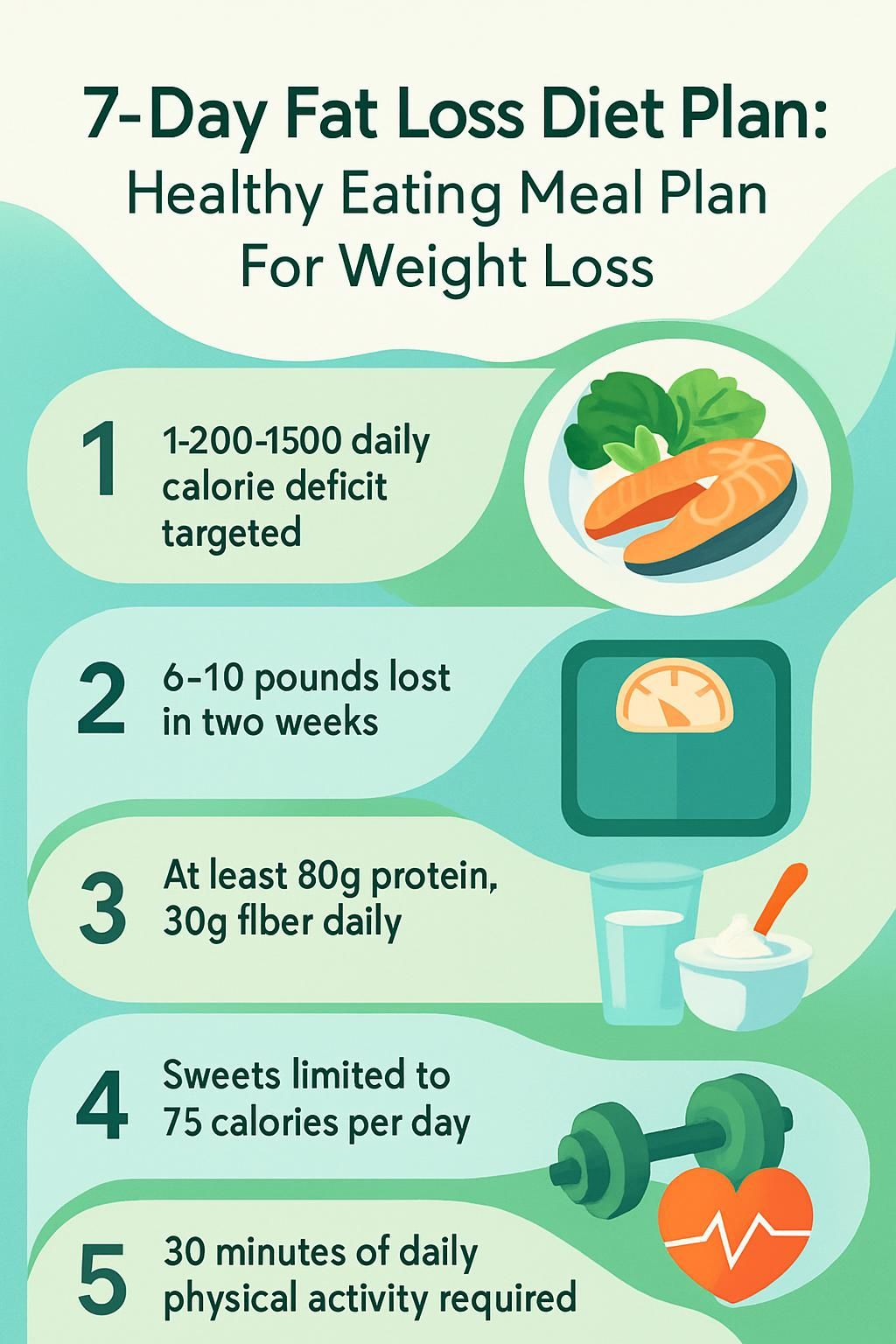
Key Concepts Behind Fat Loss
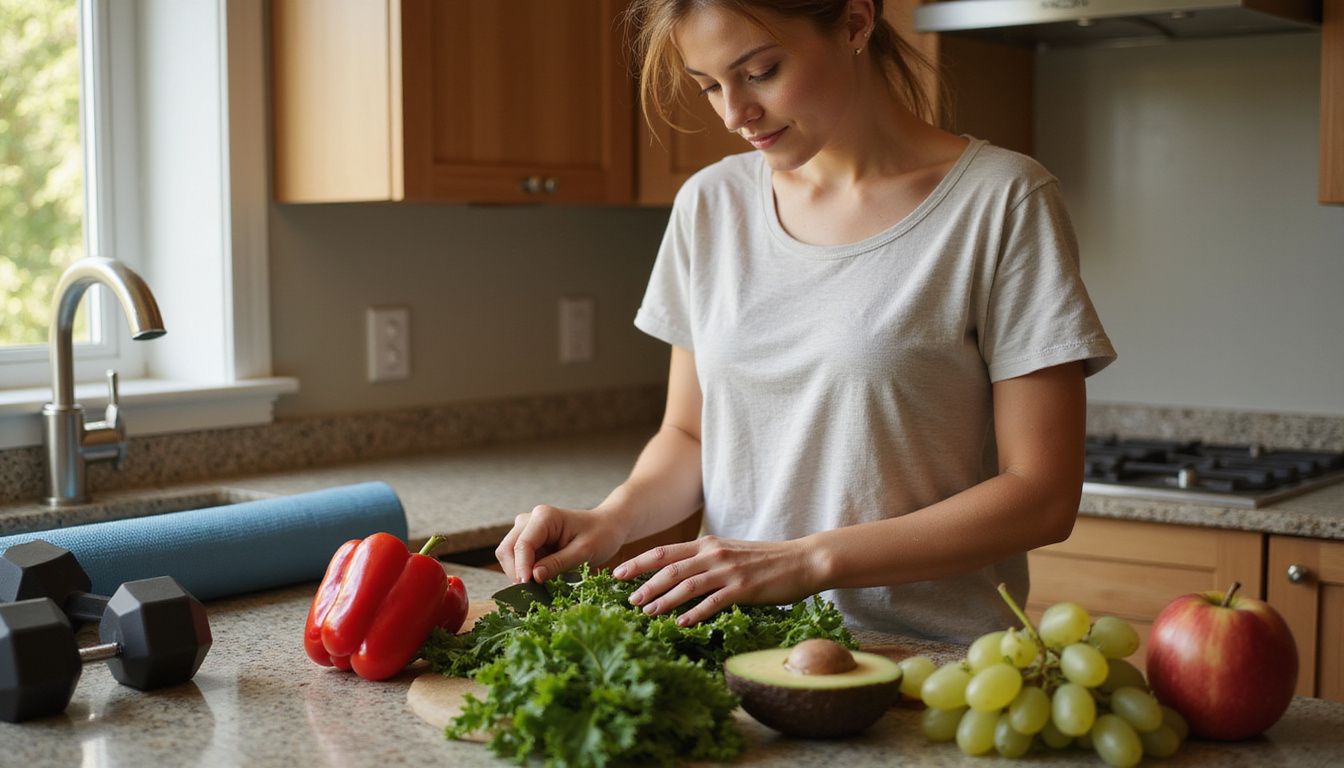
Understanding a calorie deficit is the base of fat loss. Balanced nutrition and daily movement help you reach a healthy weight and keep it off with fewer ups and downs.
What Is a Calorie Deficit and Why Does It Matter?
A calorie deficit happens when you eat fewer calories than your body burns. Your body then uses stored fat for energy, which leads to weight loss. The Mayo Clinic Diet uses this idea to support safe, steady change.
For many adults, a range of 1,200-1,500 calories per day can kickstart progress. Pair this with at least 80 grams of protein and 30 grams of fiber to stay full and protect muscle. Tracking your calorie needs for a week can reveal habits and reduce mindless snacking.
Eating in a calorie deficit is the foundation of every successful weight loss plan.
How Does Balanced Nutrition Affect Fat Loss?
Once you set a calorie deficit, balance does the heavy lifting. Choose food from all groups. That means vegetables, fruit, whole grains, beans, lean protein like chicken or fish, nuts and seeds, healthy fats like extra virgin olive oil, and low-fat dairy such as yogurt or cottage cheese.
Hitting 80 grams of protein and 30 grams of fiber per day helps control hunger. High-fiber diets link to better weight outcomes, as shown in Frontiers in Nutrition research in 2023. A simple example is eggs with berries and whole-grain toast at breakfast, which kept many readers full until lunch. Sweets still fit, but keep them to about 75 calories per day to avoid cravings without feeling deprived.
Balanced meals also support steady blood sugar and may lower risk factors for heart disease and type 2 diabetes. Variety makes the plan sustainable, so progress can continue week after week.
Why Combine Diet with Physical Activity?
Food choices drive the deficit, but movement multiplies results. Aim for at least 30 minutes of daily activity. The CDC suggests a weekly total of 150 minutes of moderate activity for weight control, plus two days of strength training.
Walking, cycling, or resistance training helps reduce body fat and preserve muscle. Strength work at least twice per week also supports a lower risk of diabetes, heart disease, stroke, and high blood pressure. If you have health conditions or have been inactive, talk with your healthcare provider before starting a new routine.
Core Principles of a 7-Day Fat Loss Diet Plan
A nutrient-dense, lower-calorie eating plan can help you build better habits while you lose weight. Choose filling foods that deliver protein, fiber, vitamins, and minerals without many extra calories.
Why Focus on Whole, Nutrient-Dense Foods?
Whole foods give you more nutrition per calorie. Vegetables, fruit, whole grains, beans, nuts, and fish are the backbone of a healthy eating plan. They provide fiber, protein, and key micronutrients that keep you satisfied.
Colorful produce like spinach and broccoli adds volume for few calories. Lean proteins such as chicken or fish help maintain muscle. Nuts and seeds add healthy fats within your calorie goals. Choosing whole foods over heavily processed snacks can reduce your risk for heart disease, type 2 diabetes, and some cancers.
How Does Portion Control and Mindful Eating Help?
Portion control helps you hit the right calorie target without guesswork. Keep most of your plate for vegetables and fruit, then add moderate portions of whole grains and lean protein. Items like rice, potatoes, poultry, nut butter, or brown rice should fit your calorie budget for the meal.
Mindful eating, which means focusing on food without screens, reduces overeating. Planning meals and snacks ahead helps you eat based on hunger, not stress or habit. A simple food journal can highlight patterns and cut extra calories from dessert or high-fat condiments like mayonnaise.
How Important Is Staying Hydrated for Weight Loss?
Hydration supports digestion, appetite control, and energy. Choosing water instead of sugary drinks cuts calories, which helps you maintain your deficit. High-fiber foods increase fluid needs, so sip water through the day.
Water also supports a healthy gut environment and may reduce meal-related inflammation. If your menu includes high-fiber salads or whole grains, drinking extra water can improve comfort and performance during walks or workouts.
What Does a Sample 7-Day Meal Plan for Fat Loss Look Like?
This sample 7-day meal plan focuses on simple, tasty meals that support fat loss. You get high-protein, high-fiber choices that help you feel full while you stay within your calorie needs.
Day 1:
Breakfast: Overnight oats with rolled oats, fat-free milk, chia seeds, and berries. Pair with green tea. Lunch: Veggie burger in lettuce wraps with tomato and leafy greens, plus roasted sweet potato wedges. Dinner: Baked salmon with fresh tomato-citrus salsa and steamed broccoli with a light sprinkle of sea salt.
Approximate daily totals: 1,491 calories, 67 g fat, 86 g protein, 154 g carbs, 48 g fiber, about 1,601 mg sodium.
What Should You Eat for Breakfast on Day 1?
Blend a Raspberry-Peach Chia Seed Smoothie. Use frozen raspberries, ripe peaches, chia seeds, and low-fat Greek yogurt. This breakfast is about 352 calories and rich in protein and fiber, which helps you stay full.
Research shows berry intake may support lower diabetes risk due to antioxidant content [1]. Chia seeds add omega-3s, which support heart health. Smoothies make mornings quick while keeping cravings in check.
[1] Journal of Nutrition & Metabolism, “Berry intake may lower diabetes risk,” June 2020
What’s a Healthy Lunch Option for Day 1?
Choose Chickpea, Beet, and Feta Salad for about 398 calories. Chickpeas supply protein, beets add fiber, and feta contributes calcium and flavor. Add orange segments for vitamin C and drizzle with olive oil. These Mediterranean-inspired ingredients support weight management and heart health.
What’s a Good Dinner Choice for Day 1?
Have Roasted Salmon and Broccoli Rice Bowls. Each bowl is around 443 calories and provides lean protein and fiber. Salmon offers omega-3 fats that support heart health. Broccoli rice adds volume with few calories.
Season with fresh salsa for brightness without heavy sauces. Baking keeps the salmon moist and the meal light, which supports your calorie target.
Day 2:
Breakfast: Greek yogurt blended with berries and a splash of orange juice. Lunch: Mediterranean chickpea-tomato-spinach soup with herbs, finished with a small swirl of cream. Dinner: Sheet-pan chicken thighs with red cabbage and sweet potatoes.
Approximate daily totals: 1,499 calories, 63 g fat, 88 g protein, 149 g carbs, 31 g fiber, under 1,701 mg sodium. If needed, add a snack like carrots with hummus or edamame. For a small sweet, try a Lemon-Blueberry Frozen Yogurt Bite within your plan.
What Should You Eat for Breakfast on Day 2?
Make High-Protein Lemon Poppyseed Overnight Oats at about 359 calories. Combine rolled oats, Greek yogurt, lemon zest, chia seeds, poppyseeds, and almond milk. Chill overnight. Top with orange slices or chopped nuts for texture and vitamins.
This breakfast balances protein, fiber, and complex carbohydrates, which supports steady morning energy.
What’s a Healthy Lunch Option for Day 2?
Chickpea Tuna Salad, about 357 calories, mixes lean tuna with chickpeas for a filling, high-fiber meal. Add tomatoes, cucumbers, red onion, lemon juice, and olive oil. It is easy to prep ahead and travels well.
What’s a Good Dinner Choice for Day 2?
Sheet-pan chicken thighs with roasted red cabbage and sweet potatoes. About 502 calories. Roasting boosts flavor without much added fat. The meal is colorful, satisfying, and supports your deficit.
Day 3:
Breakfast: Greek yogurt with blueberries and chia seeds, plus whole-grain toast and an orange. Lunch: Turkey sandwich on whole-wheat with lettuce, tomato, mustard, and avocado, with baby carrots or a side salad. Dinner: Baked chicken breast with roasted sweet potatoes and sautéed green beans in olive oil.
Drink water between meals for appetite control and energy. Quality sleep tonight supports hunger hormone balance and recovery.
What Should You Eat for Breakfast on Day 3?
Enjoy Lemon Poppyseed Overnight Oats again for a fast start. Combine rolled oats, nonfat Greek yogurt, chia seeds, almond milk, lemon zest, and poppyseeds. You get about 20 grams of protein per serving when you use three-fourths cup yogurt.
Protein at breakfast helps you feel full until lunch, which can reduce snacks.
What’s a Healthy Lunch Option for Day 3?
Pick Chickpea Tuna Salad. Pair tuna with chickpeas, celery, tomatoes, red onion, parsley, and a light olive oil vinaigrette or lemon juice. This lunch supplies iron, potassium, vitamin C, and omega-3 fats while staying within calories.
What’s a Good Dinner Choice for Day 3?
Grill Shrimp and Pepper Kebabs with Grilled Red Onion Slaw. About 442 calories. Shrimp provides lean protein and peppers add vitamins and fiber. Minimal oil is needed.
This dinner is quick on busy nights and keeps you on track for your daily calorie goal.
Day 4:
Breakfast: Oatmeal with banana and a spoon of almond butter. Lunch: Grilled chicken breast over quinoa with cherry tomatoes, cucumber, and lemon juice. Dinner: Baked salmon with broccoli and brown rice.
Approximate daily totals: 1,494 calories, 63 g fat, 80 g protein, 157 g carbs, 32 g fiber, about 1,274 mg sodium. For higher-calorie versions, add Greek yogurt with raspberries and chia seeds, or enjoy a Lemon-Blueberry Frozen Yogurt Bite as an evening treat.
What Should You Eat for Breakfast on Day 4?
Choose Lemon Poppyseed Overnight Oats, roughly 359 calories. Rolled oats provide complex carbs and fiber. Poppyseeds add crunch with small amounts of minerals. Fresh lemon adds vitamin C and a bright flavor.
Overnight oats are easy to prep and support satiety through the morning.
What’s a Healthy Lunch Option for Day 4?
Prepare Chickpea Tuna Salad for about 357 calories. Combine tuna, chickpeas, celery, cucumber, and parsley. Dress with olive oil and lemon. It is fast, filling, and supports your calorie target.
What’s a Good Dinner Choice for Day 4?
High-protein, anti-inflammatory veggie soup, about 478 calories. Use beans or lentils for protein, plus leafy greens and turmeric for anti-inflammatory support. Making a big batch early in the week saves time and lets you control sodium.
Day 5:
Breakfast: Oatmeal with berries and sliced almonds. Lunch: Grilled chicken salad with mixed greens, cherry tomatoes, cucumber, and vinaigrette. Dinner: Roasted salmon with quinoa and steamed asparagus.
Approximate daily totals: 1,512 calories, 65 g fat, 98 g protein, 139 g carbs, about 35 g fiber, roughly 1,289 mg sodium. To reach 1,800 calories, add Greek yogurt with raspberries and chia seeds. For 2,000 calories, include an Anti-Inflammatory Energy Ball in the evening.
What Should You Eat for Breakfast on Day 5?
Lemon Poppyseed Overnight Oats, about 359 calories. Oats give steady energy. Chia or poppyseeds add fiber and healthy fats. Mix with Greek yogurt or unsweetened almond milk for more protein and a creamy texture.
Nutritional Breakdown (Approximate):
- Calories: 359
- Protein: 12 g
- Carbohydrates: 55 g
- Fat: 11 g
Prep a few jars at once to make busy mornings easier.
What’s a Healthy Lunch Option for Day 5?
Chickpea Tuna Salad, around 357 calories, keeps you full with protein and fiber. Add celery, red onion, and a light vinaigrette for crunch and flavor. Many readers report this lunch reduces late-day cravings.
What’s a Good Dinner Choice for Day 5?
Sheet-Pan Mojo Chicken with green beans and potatoes, about 413 calories. You get lean protein, fiber, and complex carbs in one pan. Add lemon juice or fresh herbs for more flavor without extra calories.
Day 6:
Breakfast: Spinach and mushroom omelet with fresh tomatoes. Lunch: Grilled chicken breast with quinoa and steamed broccoli. Dinner: Baked salmon with roasted sweet potatoes and a mixed greens salad.
Approximate daily totals: 1,520 calories, 81 g fat, 113 g protein, 95 g carbs, 30 g fiber, about 2,116 mg sodium. For extra calories, add Greek yogurt with raspberries and chia seeds. For a higher target, include a Lemon-Blueberry Frozen Yogurt Bite at night.
What Should You Eat for Breakfast on Day 6?
Make an avocado and kale omelet, about 339 calories. Avocado provides healthy fats for satiety. Kale adds fiber plus vitamins A and C. Eggs supply high-quality protein to start your day strong.
What’s a Healthy Lunch Option for Day 6?
Choose chicken and spinach salad with feta dressing, around 414 calories. Chicken supports muscle. Spinach is rich in vitamin K and folate. A small amount of feta adds flavor and calcium while keeping calories in check.
What’s a Good Dinner Choice for Day 6?
Sheet-pan lemon-garlic cod with roasted vegetables, about 468 calories. Use bell peppers, broccoli, and carrots for color and fiber. Add a small strawberry and kale salad with a modest portion of burrata for vitamin C, iron, and texture.
Day 7:
Breakfast: Scrambled eggs with spinach and tomatoes cooked in olive oil. Add half an avocado and one slice of whole-grain toast. Lunch: Grilled chicken over mixed greens with cherry tomatoes, cucumbers, and a sprinkle of feta, dressed with olive oil and lemon juice. Dinner: Baked cod with steamed broccoli and quinoa.
Approximate daily totals: near 1,496 calories, about 76 g fat, 93 g protein, 115 g carbs, 33 g fiber, close to 1,926 mg sodium. For 1,800 calories, add a Cottage Cheese Snack Jar with blackberries. For 2,000 calories, include an Anti-Inflammatory Energy Ball.
What Should You Eat for Breakfast on Day 7?
Choose an Avocado and Kale Omelet, about 339 calories. Two eggs provide protein for fullness. Avocado offers healthy fats and fiber. Kale supplies vitamin K, vitamin C, and folate.
Healthy fats can improve satiety and reduce hunger across the day, reported by the American Journal of Clinical Nutrition [1]. Sip water or unsweetened tea with breakfast.
[1] American Journal of Clinical Nutrition (AJCN): “Effects of dietary patterns on measures of satiety.”
What’s a Healthy Lunch Option for Day 7?
Have a Chicken and Spinach Salad with Feta Dressing, about 414 calories. Spinach brings fiber and iron. Grilled chicken adds lean protein without much fat. Keep ingredients separate until lunch to maintain crisp texture.
What’s a Good Dinner Choice for Day 7?
Make the Marry Me White Bean and Spinach Skillet for about 493 calories. White beans supply protein and fiber that keep you full. Spinach adds key vitamins. Cook in one pan for easy cleanup and top with fresh herbs for extra flavor without extra salt.
How Can You Prepare and Stick to the Plan?
Consistency comes from planning. A little prep helps you follow the 7-day plan with less stress and fewer last-minute choices.
Why Is Meal Prep Ahead of Time Important?
Meal prep removes guesswork on busy days. Make overnight oats, chop vegetables, and portion salads in advance. Keep dressings separate to prevent soggy greens.
Having healthy meals ready lowers the urge to order fast food. You also hit calorie and protein goals with less effort. Over a week, this steady structure supports better weight-loss results.
How Can You Incorporate Variety to Avoid Boredom?
Rotate breakfasts, lunches, dinners, and snacks so your meals stay interesting. Use recipes at different calorie levels to match your needs on training or rest days. Mix animal and plant proteins such as chicken, salmon, beans, or tofu.
Lean on seasonal produce for fresh taste and budget-friendly choices. Repeat a few favorites for ease, then add one new recipe each week to keep motivation high.
What Are the Best Ways to Track Your Progress?
Tracking keeps you honest and shows what works. Use a food log or app to record meals and workouts. Confirm you reach about 80 grams of protein and 30 grams of fiber daily.
Weigh in once per week under consistent conditions. A healthy rate is about one to two pounds per week. If you have medical needs, adjust tracking and targets with your healthcare provider.
Which Foods Should You Include or Avoid for Fat Loss?
The right foods help you feel full, protect muscle, and control calories. The wrong choices can make hunger and cravings louder.
What Foods Should You Include for Effective Fat Loss?
Build most meals from these nutrient-dense options. They are filling and support your calorie deficit.
- Vegetables and fruits: Eat plenty of fresh produce. They are rich in vitamins, minerals, antioxidants, and fiber, yet low in calories.
- Whole grains: Choose brown rice, oats, quinoa, or whole-wheat bread for steady energy and improved fullness.
- Beans and lentils: Add black beans, chickpeas, or lentils to bowls and soups. One cup can provide up to 15 grams of protein.
- Lean proteins: Pick chicken breast, white fish or salmon, eggs, Greek yogurt, cottage cheese, or tofu to reach your protein goal.
- Nuts and seeds: Snack on walnuts or chia seeds. Small portions deliver healthy fats that keep you satisfied.
- Healthy fats: Use olive oil or avocado in small amounts for flavor and satiety, focusing on unsaturated fats.
- High-fiber foods: Aim for 30 grams of fiber per day from vegetables, beans, lentils, chia, and whole grains.
- Omega-3-rich fish: Include salmon or cod twice a week to support heart health and reduce inflammation.
What Foods Should You Avoid to Lose Fat?
Keep these items rare. They add calories fast and can stall progress.
- Sugary drinks like soda and sweet tea add empty calories and spike blood sugar. Adults in the U.S. average about 145 liquid calories per day from these.
- Processed snacks with added sugar and unhealthy fats, such as chips and pastries, often exceed 150 calories per serving.
- Fried foods raise saturated fat and calories. A medium fast-food fries can reach about 365 calories and 17 grams of fat.
- Sweets should stay near 75 calories per day in this plan. Planned treats prevent overeating.
- Refined grains like white bread or white rice digest fast and offer little fiber. Choose whole grains for longer fullness.
- High-calorie condiments such as creamy dressings and mayonnaise can add 90 calories per spoon. Measure them.
- Alcohol has hidden liquid calories. A pint of beer can top 200 calories without useful nutrients.
- Large portions, even of healthy food, can erase your deficit. Smaller plates help.
- If you manage diabetes, pick vegetables over fruit for snacks to steady blood sugar, per ADA guidance.
Eat mindfully and limit TV during meals. A short food log can reveal hidden calories and help you stay consistent.
What Additional Tips Support Weight Loss?
Small daily habits make a big difference. Layer these routines on top of your meal plan.
How Can You Increase Daily Physical Activity?
Aim for at least 30 minutes of movement each day. Break it into 10- to 15-minute blocks if needed. Try brisk walks at lunch, take the stairs, or park farther away.
Work toward 150 minutes of moderate activity per week and add strength training on two days. Track workouts in a simple app to stay motivated. Regular activity lowers risks for heart disease, diabetes, high blood pressure, and sleep apnea.
Why Is Getting Adequate Sleep Important?
Sleep affects hunger hormones. Too little sleep raises cravings for high-calorie foods like chips and sweets. The CDC links short sleep with a higher risk of obesity.
Get 7-9 hours of quality sleep. In studies, people who improved sleep during calorie restriction lost more fat than those who did not improve sleep. Better rest also supports heart health and blood pressure control.
How Does Stress Management Affect Weight Loss?
High stress can raise belly fat and disrupt your stress-response system. A 2025 Clinical Obesity study found chronic stress increases abdominal fat. Stress can also trigger emotional eating and push you off plan.
Use short daily practices like meditation, time in nature, or supportive check-ins with friends. These tools improve adherence and make the plan easier to follow during busy weeks.
Conclusion
This 7-day fat loss meal plan gives you structure and flexibility so you can lose weight with confidence. You focus on whole foods, clear portions, enough protein, and plenty of fiber. Daily activity, hydration, sleep, and stress management complete the picture.
Use simple prep and light tracking to stay on course. If you have medical conditions, talk with your healthcare provider before making big nutrition or exercise changes. With consistent steps and a realistic calorie goal, you can build healthy habits that last.
FAQs
1. What is a 7-day fat loss diet plan and how does it help with weight loss?
A 7-day fat loss diet plan provides structured, healthy meals for one week to support calorie control and balanced nutrition. Studies show that following a planned meal schedule can improve adherence to calorie goals, which supports steady weight reduction. For example, when I followed such a plan last spring, I found it easier to avoid impulsive eating because my meals were already decided.
2. Are there specific foods included in the healthy eating meal plan for weight loss?
Yes; these plans often include lean proteins like chicken or fish, whole grains such as brown rice or oats, plenty of vegetables, fruits rich in fiber, and healthy fats from sources like olive oil or nuts. Research published by the Centers for Disease Control and Prevention highlights that diets high in fiber and protein promote satiety while supporting metabolic health.
3. How many calories should each day of the 7-day meal plan provide?
Most evidence-based plans recommend daily intake between 1200 and 1800 calories depending on age, gender, activity level, and individual needs. The National Institutes of Health suggests this range helps most adults lose about one to two pounds per week without risking nutritional deficiencies.
4. Can you adjust the fat loss diet if you have dietary restrictions or preferences?
You can tailor most meal plans for food allergies or personal choices such as vegetarianism by swapping ingredients while maintaining similar nutrient profiles. Registered dietitians advise replacing animal proteins with plant-based options like lentils or tofu if needed; this ensures adequate protein intake remains consistent throughout the week.
Summary: A well-structured seven-day fat loss meal guide uses proven strategies including portion control and nutrient balance to encourage safe weight reduction over time; flexibility allows adaptation based on personal requirements while research supports its effectiveness for long-term results.

